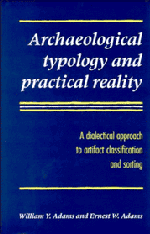 Archaeological Typology and Practical Reality
Archaeological Typology and Practical Reality Book contents
- Frontmatter
- Contents
- List of figures
- List of tables
- The archaeologist's preface
- The philosopher's preface
- PART I Introductory
- PART II The nature of types and typologies
- PART III Typology in action: the Medieval Nubian Pottery Typology
- PART IV Pragmatics of archaeological typology
- PART V Classification, explanation, and theory
- Appendices
- A Glossary of definitions
- B Specimen pottery ware description: Terminal Christian Decorated White Ware
- C Estimated dates for pottery wares found in Nubia
- D Examples of pottery ware distribution data from Qasr Ibrim
- References
- Index
B - Specimen pottery ware description: Terminal Christian Decorated White Ware
Published online by Cambridge University Press: 23 November 2009
- Frontmatter
- Contents
- List of figures
- List of tables
- The archaeologist's preface
- The philosopher's preface
- PART I Introductory
- PART II The nature of types and typologies
- PART III Typology in action: the Medieval Nubian Pottery Typology
- PART IV Pragmatics of archaeological typology
- PART V Classification, explanation, and theory
- Appendices
- A Glossary of definitions
- B Specimen pottery ware description: Terminal Christian Decorated White Ware
- C Estimated dates for pottery wares found in Nubia
- D Examples of pottery ware distribution data from Qasr Ibrim
- References
- Index
Summary
Family N Group N.VII
Ware W14. Terminal Christian decorated white ware
A rather heavy matte white ware decorated in Style N.VII; the most distinctive ware of the Terminal Christian period. It is presumably evolved from Wares W15 and W16 in Group N. VI, but is distinguished from them by its bolder and simpler decorative style and a distinctive, rather heavy group of vessel forms.
CONSTRUCTION: Wheel-made.
FABRIC: Paste: Nile mud. Density: Medium. Texture: Medium. Color: Tan, light brown or red-brown shading to darker, often purplish core (typical Munsell signatures 2.5YR 4/5, 2.5YR 6/6). Carbon streak: Occasional; seldom dark. Hardness: Generally medium soft (Mohs' value 2.5 to 4.5, av. 3.0). Solid temper: Fairly abundant fine sand, black and red fragments. Organic temper. None seen. Variability: Apparently low. Remarks: Same fabric as Ware R28.
SURFACES: Covering: Medium thick, soft slip. Finish: Matte or sometimes lightly polished. Texture: Usually rather chalky or gritty. Configuration: Level; rotation marks not prominent on interiors. Variability: Surfaces may be matte or lightly polished; never glossy.
VESSEL FORMS: Most common forms: Cups, plain bowls, vases (Fig. 11). Less common forms: Goblets, footed bowls, lids, jars (Fig. 11). Forms not illustrated: A9, A20, A23, D44, D47, F27A, Q6. Doubtful forms: C12, C34, C42, F16. Vessel sizes: Mostly medium. Rims: Rounded, frequently thickened. Bases: Ring almost completely absent; a few examples of very low, solid ring base on footed vessels. Wall thickness: Generally notably thick., especially in larger vessels (7–13 mm, av. 9.6 mm). Execution: Generally fairly precise.
- Type
- Chapter
- Information
- Archaeological Typology and Practical RealityA Dialectical Approach to Artifact Classification and Sorting, pp. 373 - 376Publisher: Cambridge University PressPrint publication year: 1991
